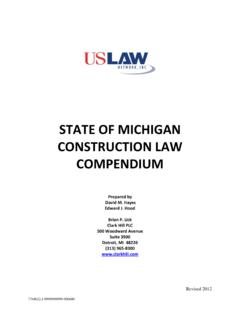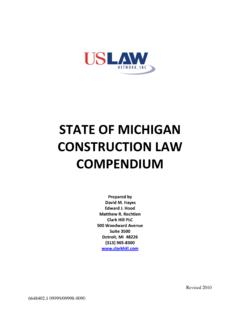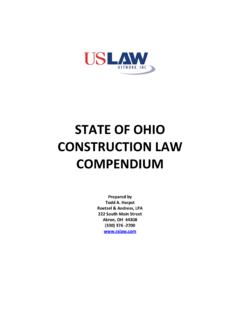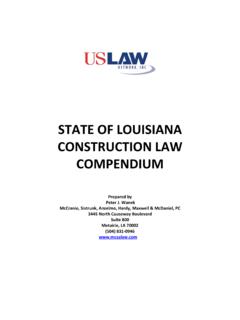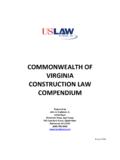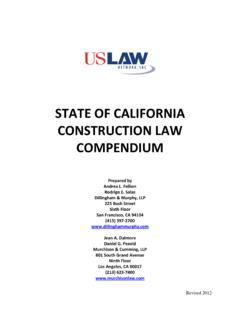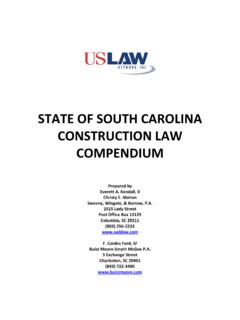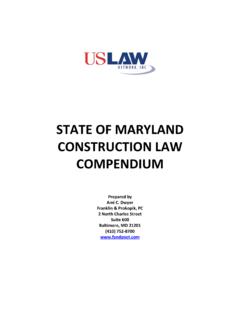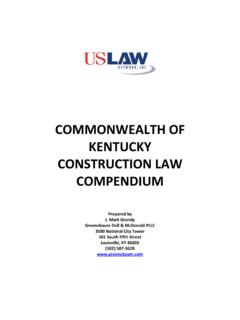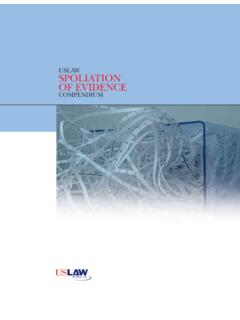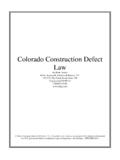Transcription of STATE OF TEXAS CONSTRUCTION LAW COMPENDIUM
1 Revised 2014 STATE OF TEXAS CONSTRUCTION LAW COMPENDIUM Prepared by1 Thomas W. Fee & Rebecca E. Bell Fee Smith Sharp & Vitullo, LLP 13155 Noel Road, Suite 1000 Dallas, TEXAS 75240 (972) 934-9100 Jonathan Schlueter & Brett W. Schouest Cox Smith Matthews Incorporated. 112 East Pecan Street, Suite 1800 San Antonio, TX 78205 (210) 554-5500 Lawrence J. West & Joshua W. Mermis Johnson Trent 919 Milam Street, Suite 1700 Houston, TX 77002 (713) 222-2323 1 The names listed above are ordered solely by way of the alphabet significant contributions were made by all of these individuals in the updating of this COMPENDIUM , and all deserve equal recognition and appreciation. REB 2 Revised 2014 I. INTRODUCTION CONSTRUCTION defect litigation in TEXAS is both standard and unique although lock-step with the majority of jurisdictions in some areas, the depth and breadth of legislation and interpretative common law necessitates careful attention when dealing with a CONSTRUCTION defect claim in TEXAS .
2 This COMPENDIUM update attempts to merely survey general subject matters and is not intended as a complete analysis of any specific topic. Please note that the law applicable to CONSTRUCTION litigation in TEXAS , particularly insurance coverage issues, continuously evolves. Although this COMPENDIUM attempts to capture the latest cases, statutes and trends, as well as clarify matters that warrant specific distinction from prior COMPENDIUM publications, please confirm the current STATE of TEXAS law at the time your client is faced with a defect case in TEXAS . II. CONSTRUCTION DEFECT CLAIMS ON RESIDENTIAL STRUCTURES The authors of this COMPENDIUM believe that mention should be made early in this update to eliminate any confusion with law as discussed in the last publication; specifically, the TEXAS Residential CONSTRUCTION Liability Act (RCLA) and its most significant modification that occurred in the TEXAS Residential CONSTRUCTION Commission Act (TRCCA), effective September 1, 2003.
3 Despite initial enthusiasm in TRCCA, the TEXAS Legislature allowed the TRCCA to sunset in 2009, with an extension for one year claim openings, thus ending the application of TRCCA on August 31, 2010. With the sunset of the TRCCA, perceived conflicts between RCLA and TRCCA resolved themselves somewhat naturally from an administrative standpoint. For houses built before the effective date of the TRCCA standards, June 1, 2005 or after the demise of the TRCC, September 2009, the standards of TRCCA do not apply. RCLA now supplants the TRCCA as the most important (and only) statutory scheme in TEXAS that applies to all residential CONSTRUCTION defect claims. A. HISTORY OF RCLA Chapter 27 of the TEXAS Property Code, commonly referred to as RCLA, was created in 1989 in response to disproportionate jury verdicts rendered in residential CONSTRUCTION trials.
4 RCLA is not a cause of action, however. The purpose of RCLA was to limit the application of the TEXAS Deceptive Trade Practice Act ( DTPA ), which had led to many windfall cases for the plaintiff/homeowner. To best understand how RCLA works, it is best to imagine it as a filter applying defenses and damage limitations to bar conflicting remedies and provide proof requirements and damages based on statutory and common law causes of action for residential CONSTRUCTION defect claims. 3 Revised 2014 B. APPLICATION OF RCLA The RCLA sets forth detailed procedures for notice, inspection, and settlement of claims arising from CONSTRUCTION defects . The RCLA applies to single family homes, duplexes, triplexes, quadruplexes, condominium units and units in cooperative systems. Essentially, a claimant seeking damages from a contractor, or other relief from a CONSTRUCTION defect, is obligated to provide notice of the alleged defect to the contractor, produce evidence depicting the nature and cause of the defect and the nature and extent of repairs necessary, and provide the contractor with a reasonable opportunity to inspect the property.
5 All contracts subject to the RCLA must include statutory disclosure information the consumer of the mandatory provision of RCLA (required notice and opportunity for inspection) before suit can be filed for a CONSTRUCTION defect. The RCLA provides a cap on the amount of damages a homeowner can recover once a timely and reasonable settlement offer has been made and rejected. In that event, the claimant cannot recover an amount in excess of the reasonable cost of repairs necessary to cure the CONSTRUCTION defect or the amount of the settlement offer. Furthermore, the claimant can only recover the amount of reasonable and necessary costs and attorney s fees that were incurred before the offer was rejected or considered rejected. If a contractor fails to make a reasonable offer, however, the limitation on damages does not apply and the claimant may recover the following economic damages proximately caused by the CONSTRUCTION defect: (1) the reasonable cost of repairs necessary to cure any CONSTRUCTION defect; (2) the reasonable and necessary costs for the replacement or repair of any damaged goods in the residence; (3) the reasonable and necessary engineering and consulting fees; (4) the reasonable expenses of temporary housing reasonably necessary during the repair period; (5) the reduction in current market value, if any, after the CONSTRUCTION defect is repaired if the CONSTRUCTION defect is a structural failure; and (6) reasonable and necessary attorney s fee.
6 C. REQUIRED PRE-ACTION NOTICE AND OFFER OF SETTLEMENT UNDER RCLA The statute outlines the procedures and associated deadlines for addressing a residential defect claims - Step 1: Pre-Action Notification At least 60 day before a homeowner or other authorized person (as identified above) initiates an action against a builder to recover damages or other relief arising from CONSTRUCTION defect, notice of the claim must be given to the builder by certified mail, return receipt requested, to the builder s last known address. 4 Revised 2014 Step 2: Opportunity to Inspect Once the builder received the homeowner s notice, the builder, upon written requests, has 35 days to inspect the property that is the subject of the complaint to determine the nature and cause of the defect and the nature and extent of repairs necessary to remedy the defect.
7 Step 3: Offer of Settlement Once the builder receives the homeowner s notice, the builder has 45 days to make a written offer of settlement. The written settlement offer may be made to the homeowner or to the homeowner s attorney by certified mail, return receipt requested. Step 4: Acceptance or Rejection of the Settlement Offer The homeowner has 25 days after receipt of the offer of settlement to accept or reject the offer. After the 25th day, if the offer has not been accepted, it is considered rejected as a matter of law. III. PRELITIGATION CONSIDERATIONS ALL PROJECTS A. CAUSE OF THE DEFECT CONSTRUCTION , DESIGN OR BOTH? When a defect arises, the first inquiry is the nature and cause of the defect. The contracts between the owner and the contractor and between the contractor and it sub-contractors normally require the work to (1) be constructed in accordance with the project plans and specifications; (2) meet all applicable building codes and standards; and (3) be in accordance with industry standard and good CONSTRUCTION practice.
8 The contract between the owner and the architect, and between the architect and its consultants such as engineers, require the design to comply with applicable building codes and standards, and to meet a certain standard of care. Is the defect caused by defective CONSTRUCTION , defective design, or both? Was a certain product appropriate for the specified use, or did a product fail? The careful practitioner must investigate the root cause of the problem prior to litigation. It is advisable to retain experts to provide preliminary evaluation prior to litigation. B. CLAIMS AGAINST THE ARCHITECT OR ENGINEER TEXAS law requires a party making a claim against an architect, engineer or surveyor to file a supporting Certificate of Merit with the complaint against such a design professional.
9 TEX. CIV. PRAC. & REM. CODE et seq. The Certificate of Merit is an affidavit of a third-party registered/licensed architect, engineer, or land surveyor competent to testify, knowledgeable 5 Revised 2014 and holding the same professional license or registration as the defendant. A claimant must set forth specifically, for each theory of recovery for which damages are sought, the negligence, if any, or other action error, or omission of the licensed or registered professional in providing the professional service, including any error or omission in providing advice, judgment, opinion or similar professional skill claimed to exist and the factual basis for each such claim. As such, the safer approach is to assume that the statute ostensibly applies to all claims asserted against a design professional, instead of only claims of negligence.
10 Therefore, the practitioner must retain an expert to evaluate all claims against a design professional prior to litigation of such claim. Failure to do so and attach a required Certificate of Merit can lead to mandatory dismissal of the claim, perhaps with prejudice. IV. CAUSES OF ACTION Parties to a CONSTRUCTION project typically find themselves in litigation after negotiations have broken down. What began as claims and demands for money will soon find themselves memorialized in court filings. The initiation of suit makes the dispute public and involves the judiciary and attorneys. Although lawsuits can be expensive and a laborious process, they can achieve finality and closure to what most often has become an intractable dispute. Common theories of liability for CONSTRUCTION defect lawsuits include breach of contract, quantum meruit, breach of warranty, negligence, negligent misrepresentation, fraud/fraud inducement, contribution, and indemnity.
